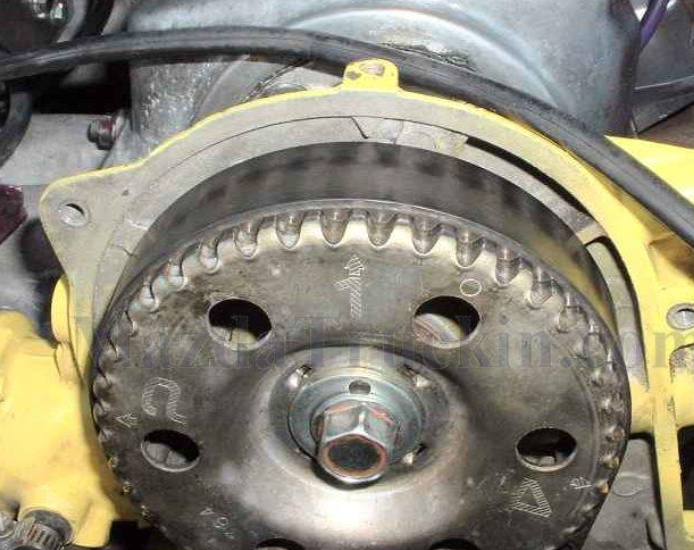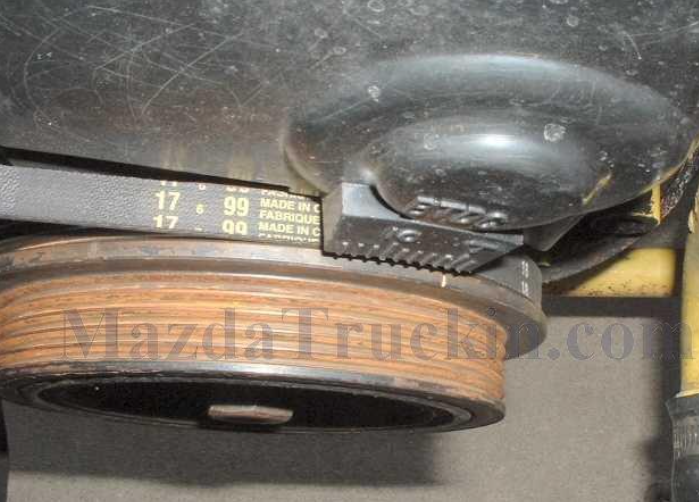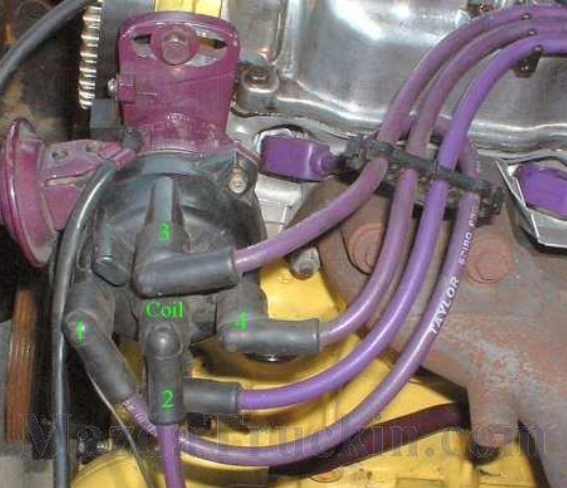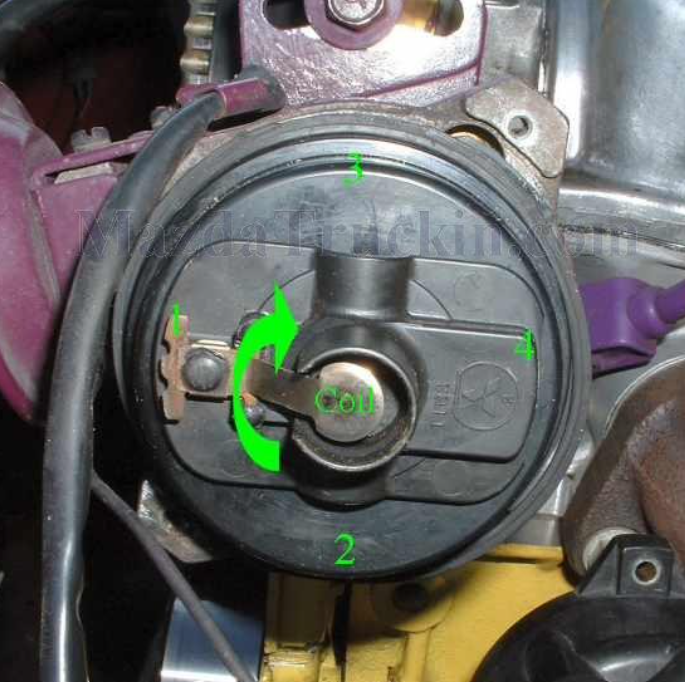One of the big problems people have with their Mazda Truck is timing. Many people will buy a truck that someone has fooled with before and since a lot of times they have never owned a Mazda before they can’t get it timed right or they decide to change the belt and can’t get it right again. This is a really quick procedure to check your timing and can also be used to pinpoint other problems in the engine without a bunch of instruments and gauges.
Ok, first off this article is based off of a Mazda B2200, this procedure should be universal with all distributor vehicles but timing marks and things like that will vary slightly between different truck models.
You will need to remove the upper timing cover so you can see the cam sprocket. It will come off with four 10mm bolts, two on top two on the bottom. My engine is fairly stripped of accessories so this takes me about 47 seconds but you may have to work around emission ducting to the exhaust and stuff like that.

This is what you should have now on the B2200, don’t worry what number is at the pointer at the moment as you now need to turn number one piston up to top dead center.
You will need a 21 mm wrench for this or at the very least, a crescent wrench.
Before trying to turn the engine make sure that the tranny is in neutral, otherwise the engine won’t turn and you risk stretching the timing belt.
Put the wrench on the crank bolt and turn it clockwise until the mark on the harmonic balancer (crank pulley) lines up with the TDC mark on the lower timing cover.
Now look at the cam sprocket the dowel in the cam should be in the hole for number 1. On some older B2000 engines they might have an A, B, & C, all alignment should be on A for these engines. If the arrow for number 1 (A) is not lined up with the arrow above the sprocket turn it over 1 (A) more time to TDC. This is VERY IMPORTANT if you go past the mark you must turn the crank back at least 1/2 a turn and then re-turn it clockwise to line it up. If you don’t lash in the timing belt will throw the entire thing off and you may think it’s wrong when it is actually timed right. At this time your cam sprocket should look precisely like the picture above and your crank pulley like the picture below… (Older B2000 should have #1 piston at TDC and cam sprocket with A pointing up.)

Now to double check and make sure that number 1 piston is at TDC. To do this you will need to remove #1 spark plug and put something like a screwdriver or a dowel rod in there, it should not go in very far before it stops. If it doesn’t go in very far turn the crank pulley a little bit, the screwdriver should move. If you put the screwdriver in there and it drops all the way down to the handle then #1 piston is in the wrong place, you will need to loosen the timing belt and rotate the pulley around 1 time until the mark lines up again. Now the screwdriver should only go in a few inches before stopping. Note: if using a screwdriver be careful, it is possible to scratch the top of the piston or damage the cylinder head. It is recommended you use something that can’t scratch metal, also be careful that you don’t drop whatever it is your using into the cylinder.
If the timing mark on the harmonic balancer is lined up, #1 piston at TDC, and the cam is installed properly then #1 cylinder should be on its compression stroke. To double check this, turn the engine over by hand with your thumb over #1 spark plug hole, as the timing mark reaches TDC AND #1 (A) on the cam sprocket lines up you should feel pressure push your thumb off the hole. Also if you remove the valve cover both valves on #1 should be fully closed and the springs uncompressed.
Now to check the distributor. It should look something like the picture below, where each wire goes depends on the firing order of your engine. On the 88-93 B2200 it is 1-3-4-2 with 1 being the cylinder at the front of the truck. So just take the 2 screws off for the distributor cap to look where the rotor button is.

Here is the Rotor Button.

The contact on the rotor button (by the #1 in picture above) should be located where number one spark plug wire would be on the distributor. If that is where it is at it should be installed properly if it is someplace else take the distributor out and line up the dimple on the gear with the mark on the distributor shaft and put it back in. Note that the distributor must be installed with the cam properly installed and all timing marks lined up.
The arrow indicates the rotor button is going to rotate clockwise as it rotates it moves past each point on the distributor cap which completes the circuit from the ignition coil to whatever plug it contacts and you get spark.
This procedure can tell you other things as well. For instance, in this picture you can clearly see my rotor button is fried and so my distributor cap probably looks about the same on the inside (and it does). This will cause any number of problems from not starting to rough idling, misfires, poor fuel mileage, and lack of power. Also if you see a lot of corrosion or black carbon build up on only one contact there is a problem with that plug or cylinder somewhere as it is requiring more power to fire. Also while your turning the engine if it doesn’t get hard to turn as the button goes past where it would make contact with one of the points then you have poor compression in the cylinder it just passed and you should do a compression check. Of course then you know that either the rings in that cylinder are bad or there is a valve train problem. Just one of the many tricks to engine diagnosis.
Leave a Reply